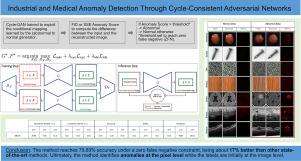Industrial and medical anomaly detection through cycle-consistent adversarial networks
IF 5.5
2区 计算机科学
Q1 COMPUTER SCIENCE, ARTIFICIAL INTELLIGENCE
引用次数: 0
Abstract
In this study, a new Anomaly Detection (AD) approach for industrial and medical images is proposed. This method leverages the theoretical strengths of unsupervised learning and the data availability of both normal and abnormal classes. Indeed, the AD is often formulated as an unsupervised task, implying only normal images during training. These normal images are devoted to be reconstructed through an autoencoder architecture, for instance. However, the information contained in abnormal data, when available, is also valuable for this reconstruction. The model would be able to identify its weaknesses by also learning how to transform an abnormal image into a normal one. This abnormal-to-normal reconstruction helps the entire model to learn better than a single normal-to-normal reconstruction. To be able to exploit abnormal images, the proposed method uses Cycle-Generative Adversarial Networks (Cycle-GAN) for (ab)normal-to-normal translation. After an input image has been reconstructed by the normal generator, an anomaly score quantifies the differences between the input and its reconstruction. Based on a threshold set to satisfy a business quality constraint, the input image is then flagged as normal or not. The proposed method is evaluated on industrial and medical datasets. The results demonstrate accurate performance with a zero false negative constraint compared to state-of-the-art methods. Quantitatively, our method reaches an accuracy under a zero false negative constraint of 79.89%, representing an improvement of about 17% compared to competitors. The code is available at https://github.com/ValDelch/CycleGANS-AnomalyDetection.

通过循环一致性对抗网络进行工业和医疗异常检测
本研究针对工业和医疗图像提出了一种新的异常检测(AD)方法。该方法利用了无监督学习的理论优势以及正常和异常类别的数据可用性。事实上,AD 通常被表述为一项无监督任务,这意味着在训练过程中只有正常图像。例如,这些正常图像致力于通过自动编码器架构进行重建。然而,异常数据中包含的信息(如果有的话)对这种重建也很有价值。通过学习如何将异常图像转化为正常图像,模型就能找出自己的弱点。与单一的正常到正常的重构相比,这种异常到正常的重构有助于整个模型更好地学习。为了能够利用异常图像,建议的方法使用循环生成对抗网络(Cycle-GAN)进行(非)正常到正常的转换。输入图像经正常生成器重建后,异常得分将量化输入图像与其重建图像之间的差异。然后,根据为满足业务质量约束而设定的阈值,将输入图像标记为正常或不正常。我们在工业和医疗数据集上对所提出的方法进行了评估。结果表明,与最先进的方法相比,该方法具有准确的性能和零假阴性约束。从数量上看,我们的方法在零假否定约束下的准确率达到了 79.89%,与竞争对手相比提高了约 17%。代码见 https://github.com/ValDelch/CycleGANS-AnomalyDetection。
本文章由计算机程序翻译,如有差异,请以英文原文为准。
求助全文
约1分钟内获得全文
求助全文
来源期刊

Neurocomputing
工程技术-计算机:人工智能
CiteScore
13.10
自引率
10.00%
发文量
1382
审稿时长
70 days
期刊介绍:
Neurocomputing publishes articles describing recent fundamental contributions in the field of neurocomputing. Neurocomputing theory, practice and applications are the essential topics being covered.
 求助内容:
求助内容: 应助结果提醒方式:
应助结果提醒方式:


